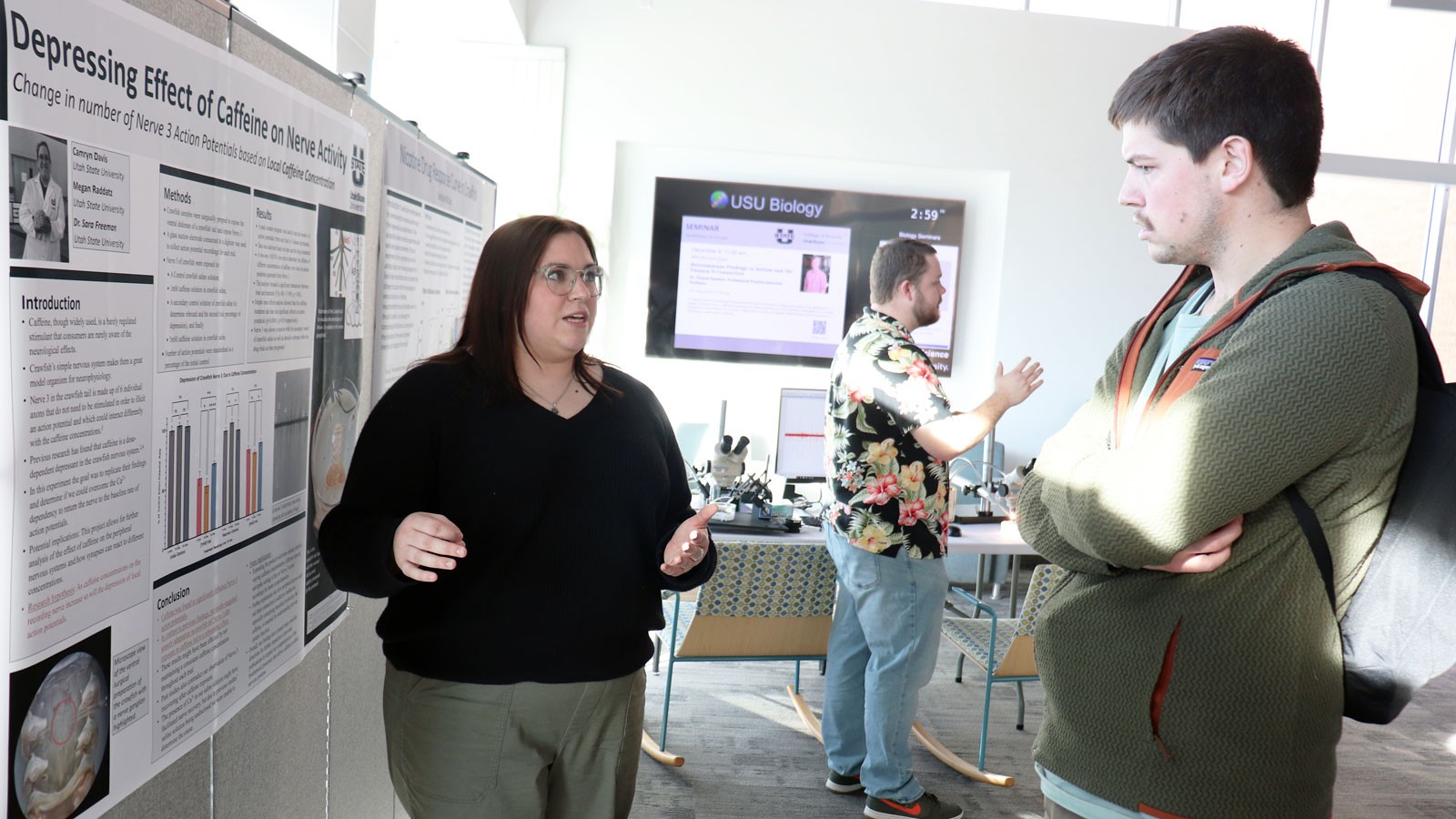Picking the Brain: USU Neurophysiology Scholars Showcase Research Projects
Biology faculty member Sara Freeman's BIOL 5625 lab course is among the university's first to achieve research-intensive designation.
By Mary-Ann Muffoletto |
Camryn Davis, left, a student in BIOL 5625 Neurophysiology Lab presents her research during the course's Dec. 6 end-of-semester poster session. The course is among USU’s first to receive the USU Office of Research’s Research, Scholarship and Creative Inquiry-Intensive designation. (Photo Credit: USU/M. Muffoletto)
Utah State University undergraduate Maren Ferre didn’t think she had a particular interest in brains. But when it came time to choose an elective, she opted for biology faculty member Sara Freeman’s Neurophysiology Lab Course, BIOL 5625.
“I’m considering a career in the medical field, possibly pharmacology, so it seemed like a good choice,” says the human biology major. “I had no idea Dr. Freeman’s neurophysiology lab, with so much hands-on learning, would become my all-time favorite lab.”
Ferre was among five scholars showcasing research projects at a Dec. 6 poster session in the Biology-Natural Resources Building’s Janet Quinney Lawson Atrium, of work they’d developed during the fall semester class. The lab course is among the university’s first four undergraduate courses receiving the USU Office of Research’s Research, Scholarship, and Creative Inquiry-Intensive (RSCI) course designation.
“This designation is given to courses that meet the criteria, including student development of a research project, structured practice of research and dissemination of that research,” says Freeman, assistant professor of neurobiology in USU’s Department of Biology. “Our poster session was the ‘dissemination’ part of the designation. The gathering gave our students an opportunity to publicly discuss their research with the greater campus community.”
Ferre, whose research project combines the 150-year-old Golgi-Cox staining technique with modern-day software to generate 3D renderings of neurons, says she and her classmates dove into mouse brain dissections during the first week of class.
“I was a little shocked at first, but it was fascinating,” she says. “Who knew you could learn so much from a tiny mouse brain?”
Nathan McCoy, also a human biology major, says he opted for the course because he’d previously taken a neurobiology class, and because it’s related to research he’s pursuing in a USU animal science lab.
“I wanted to get a more in-depth view of neurophysiology and this course piqued my passion,” says McCoy, who is conducting research on ovarian tissue transplants with faculty mentor Jeffrey Mason in the Department of Animal, Dairy and Veterinary Sciences. “My goal, following graduation from USU, is to study osteopathic medicine and pursue clinical research.”
Freeman developed the course two years ago in response to the increasing demand for more neuroscience course offerings for undergraduates. Equipment funding for the class came from USU sources, as well as a grant awarded to Freeman by Faculty for Undergraduate Neuroscience (FUN), an international organization supporting neuroscience research and education at the undergraduate level.
She secured four recording rigs — workstations including a microscope, amplifier, stimulator, electrodes, laptop computer and analytical software — used to record, visualize and analyze the electrical activity from live neurons.
“With this equipment, I can currently accommodate up to eight students per class,” Freeman says. “That’s a small number, but it also means everyone is the class gets a lot of one-on-one instruction with me and my teaching assistant. It’s a high-impact kind of class.”
She says the course is an excellent choice for students undertaking life sciences studies, including biology, psychology, neuroscience, biochemistry, kinesiology and biological engineering majors.
“The class provides opportunities to dig into research and to determine interest in future academic paths, including graduate school or medical school,” Freeman says. “The course is offered primarily for undergraduates, but we welcome graduate students as well.”
Ferre says she benefited from the course’s research-intensive atmosphere.
“It was interactive, with a lot of trial and error,” she says. “I learned a lot of about research planning and procedures that will help me in the future.”
WRITER
Mary-Ann Muffoletto
Public Relations Specialist
College of Science
435-797-3517
maryann.muffoletto@usu.edu
CONTACT
Sara Freeman
Assistant Professor
Department of Biology
435-797-0670
sara.freeman@usu.edu
TOPICS
Research 879stories Biology 166stories STEM 164storiesComments and questions regarding this article may be directed to the contact person listed on this page.







